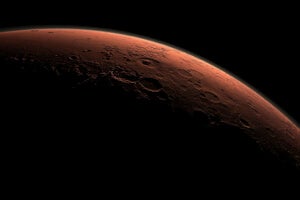It’s an exciting time for space exploration. NASA, private companies, and several countries are all racing to colonize space. Soon we hope to become a multi-planetary species. But why?
This post explores why we’re racing to the Moon and Mars and who will get there and when.
This is Part 2 of our Space GGC Series focused on important issues facing us now:
Part 1: Our Home Among the Stars
Part 2: The Race to the Moon and Mars
Part 3: Asteroid Detection and Mining
Part 4: Finding Extraterrestrial Life
The following information was curated from excerpts of previously published Singularity Hub articles on space exploration. Though this series isn’t intended to be all-inclusive, we hope collecting a few key developments and insights in one place will deliver a broader view on the field. Special thanks to Jason Dorrier and Sarah Scoles for their works quoted here.

Why Spend Billions on Space? It’s Our Insurance Policy Against Extinction
“Why blow billions of dollars on space exploration when billions of people are living in poverty here on Earth?
You’ve likely heard the justifications. The space program brings us useful innovations and inventions. Space exploration delivers perspective, inspiration, and understanding. Because it’s the final frontier. Because it’s there.
What you haven’t heard is anything to inspire a sense of urgency. Indeed, NASA’s struggle to defend its existence and funding testifies to how weak these justifications sound to a public that cares less about space than seemingly more pressing needs.
Space exploration, according to SpaceX founder Elon Musk, is as urgent as easing poverty or disease—it’s our insurance policy against extinction. Musk says an extinction-level event would, in an existential flash, make our down-to-earth struggles irrelevant.”

Diversifying Our Planetary Portfolio: The Moon Is a Stepping Stone to Mars
“Today NASA has no plans to send humans back to the Moon. Instead, its space pioneers will shoot straight to Mars (and wave to the Moon as they pass it by).
Other countries, though, would like a chance to leave some dusty footprints on the Moon. And although some think another Moon mission represents a step back, solid reasons exist (beyond footprints) to do a lunar sojourn or two before heading for the Red Planet.
In October, Russia announced it wants to build a base on the Moon. And it seems likely ESA would team up with Russia after [a joint] recon mission to spool up that Moon colony.
At the National Space Symposium in April, the agency’s chief, Johann-Dietrich Wörner said, “It seems to be appropriate to propose a permanent Moon station as the successor of ISS.” He proposed that, like the space station, the Moon station also be international, with countries contributing people, talent, and resources according to their abilities.
But aside from money matters, going to the Moon doesn’t mean not going to Mars.
Europe, Russia, and China all plan to visit the Red Planet’s canyons and dunes sometime in the future. But going to the Moon is faster—in terms of trip planning and the number of times the crew asks “Are we there yet?” before arrival—and, because of that, cheaper.
Further, because the timescales and the budget numbers are both smaller, the missions are more likely to happen (maybe even on time). Also, going to the Moon is a stepping stone to Mars. Launches to Mars could actually take place from the Moon—a lower-energy feat relative to Earth launches due to the Moon’s lesser gravity—after the colony turns industrial (which is, admittedly, a ways off). And astronauts and engineers can learn how to build a long-term space settlement, which (turns out) no one has ever done before.
However, the more resources agencies invest in getting to the Moon (and staying there for long periods of time), the fewer they have left to allocate for a future trip to Mars, an expensive endeavor. And the general American attitude of “been there, done that” has something to it. We have been there. We may not have done all of that, but we could go try to do it somewhere else, farther away: on a new frontier.
That kind of novel, dreamy goal inspires people, and not without reason. We have the technological capability to figure out how to make a human Mars mission work.”

Who Will Become the First Martian? Collaboration May be the Key
“[Last September, NASA] reaffirmed its commitment to rocket humans to Mars by the 2030s. At the same event, however, they also delayed the first crewed flight of Orion, the space capsule they plan to use for the voyage. Called EM-2, this flight was once scheduled for August 2021. But because of new design changes, the mission will now have to wait until April 2023.
The agency said that the rain-check shouldn’t change the rest of Orion’s calendar, and the first no-crew test will still take place in 2018.
[Still] NASA is a big federal agency, and its engineers and scientists have to deal with budget constraints, government appropriations, piles of paperwork, and existing relationships with other big, cumbersome organizations like Lockheed Martin and Boeing.
And it’s the big-slow-cautious gap that private companies and nonprofit organizations are stepping into. “We want to go to Mars, too,” they say. And they bet they can do it better, faster, and cheaper.
Currently, SpaceX flies supplies to the International Space Station, but it plans to settle a colony on Mars. And [Elon] Musk (and his army of smart people who work really hard) might be able to do that. While the details of SpaceX’s Mars ferry (called the Mars Colonial Transporter) remain behind the company’s doors, Musk recently told Vogue magazine that his first astronaut-colonists should be headed out in about 10 years.
On the opposite end of the private path-to-Mars spectrum lies Mars One, a Dutch company founded by Bas Lansdorp. Mars One offers a one-way trip for six groups of four astronauts — chosen from the thousands who applied online. The selection process was to become a reality television show, with crews beginning training in 2016 for a launch in 2026, a timeline roughly on par with Musk’s. However, as a high-ranking applicant detailed in this Medium article, Mars One doesn’t seem to have the infrastructure or technology connections to back up their plan.
More moderate in their dreams, [Dennis Tito’s] Inspiration Mars Foundation first planned to send a two-person crew to fly by Mars in 2018, as a stepping stone like NASA’s asteroid plan.
But in February 2014, Tito pushed back the launch to 2021 and said he would need NASA’s Orion and SLS structures. While no plans exist between the agency and Inspiration Mars, collaborations like this may be the best way to get to Mars.
NASA, for instance, already collaborates with SpaceX for near-Earth projects. The two could join forces — combining the best of both organizations, like NASA’s attention to detail and safety and SpaceX’s willingness to experiment and act quickly — to get to Mars sooner with the smallest number of snags possible.
If all of these ventures succeeded, Mars might become crowded. But it seems likely that some combination of them will, in the coming decades, join forces — physically, intellectually, or both — to sum their individual strengths and to water down their weaknesses.”
That wraps up Space and Technology Review Part 2. Read Part 1 here and stay tuned for Parts 3 and 4.
Banner Image Credit: NASA



